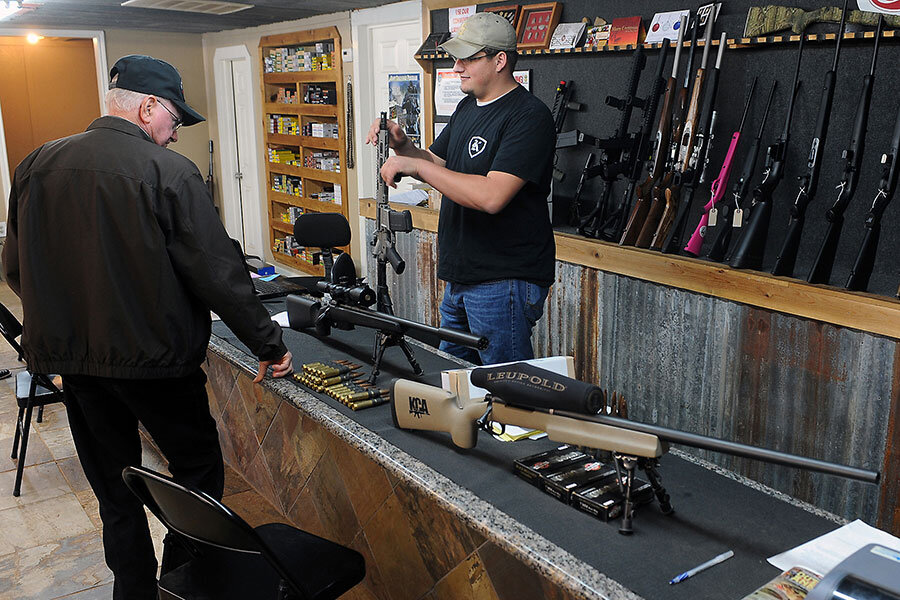Supreme Court battle on assault weapons looms. But do bans do anything?
Loading...
| New York
When a federal appeals court upheld bans on military-style assault rifles in New York and Connecticut Monday, it nevertheless recognized a fact that gun rights advocates have long highlighted: such popular semiautomatic rifles register barely a blip on gun-related crime.
Even as traumatic mass shootings have hit the country time and again during the past few years, perpetrators use semiautomatic assault rifles to kill people far less often than even knives or hammers, critics of assault rifle bans often say.
There were nearly 12,000 murders in the United States in 2014, and of these, only 248 were perpetrated with rifles of any sort, according to Federal Bureau of Investigation statistics. Handguns, by contrast, constitute nearly half of murders in the United States, and knives were used to kill more than 1,500 people nationwide in 2014.
"That may be so,” the appeals panel on the US Second Circuit said. “But gun control legislation 'need not strike at all evils at the same time' to be constitutional."
The statement was a nod to the fact that assault weapons bans, like New York’s and Connecticut's as well as those stalled before Congress, may do little to curb overall gun violence. But it also suggests that such laws can still have an important effect by setting a national tone and taking these weapons out of the hands of mass shooters.
“Part of it is the symbolic element of so-called assault weapons representing the scariest and most negative aspects of guns and gun violence in American society,” says Donald Haider-Markel, a political scientist at the University of Kansas who studies the politics of gun control. “But the argument about stopping mass shootings is not a trivial one.”
New York and Connecticut enacted their gun bans in 2013 – a direct response to the 2012 mass murders at Sandy Hook Elementary School in Newtown, Conn. There, a young gunman used a semiautomatic rifle to fire 154 rounds in less than five minutes, killing 20 first graders and six teachers and administrators. The laws ban most versions of military-style assault rifles and restrict ammunition magazines that can hold more than 10 bullets.
The case may be heading to the Supreme Court, but such bans are not new. From 1994 to 2004, the federal government similarly banned the manufacture, sale, and distribution of assault weapons nationwide, and also included restrictions on magazines with more than 10 rounds.
The law included a “sunset” provision ending the ban in 2004, and Congress, as well as most states, haven’t enacted similar bans on such weapons since.
But Congress did authorize a series of three studies to measure the impact of the assault weapons ban, including a 2004 study led by Christopher Koper, “An Updated Assessment of the Federal Assault Weapons Ban: Impacts on Gun Markets and Gun Violence, 1994-2003.”
The final report in the series concluded that the federal bans success was “mixed.”
Crimes involving assault weapons did decline, but this decline was offset, the report concluded, by an increase in the use of other guns equipped with high-capacity magazines. It also concluded, however, that it was “premature to make definitive assessments of the ban’s impact on gun crime,” and its overall effects were “still unfolding” when the law expired.
For many advocates of these bans, reducing the country’s ongoing mass shootings – and not simply overall gun crime – is part of the intention of such laws.
“It has become a gun rights meme, that these gun bans are all cosmetic,” says Saul Cornell, chair of American history at Fordham University in New York and an expert in Second Amendment issues. “And at the level of ballistics, that may be true,” he says, since other semiautomatic weapons could be just as lethal.
“But when you have people with impulse control issues, and you give them this very lethal and very effective tool, they will do more damage with it.”
And Professor Cornell believes that many of the perpetrators of mass shootings are enamored of the military style of these weapons, a “cosmetic” paramilitary look they seek to emulate.
Polls find significant public support for such bans, with 66 percent favoring a ban on assault-style weapons, and 67 percent favoring a ban on high-capacity ammunition magazines, according to an October survey by Morning Consult in Washington.
For the federal appeals panel, the issue was the lethal efficiency such guns provide would-be mass shooters, even if the law does not “strike at all evils at the same time.”
"Like assault weapons, large-capacity magazines result in 'more shots fired, persons wounded, and wounds per victim than do other gun attacks,' " the court said, ruling the bans a reasonable restriction on Second Amendment rights.
“The reality is, the evidence seems pretty mixed on whether or not an assault weapons ban has any direct impact on crime in the United States,” says Professor Haider-Markel. “But it’s pretty straight forward: If your goal is to reduce harm done in mass shootings, I think these laws can contribute to this goal.”








